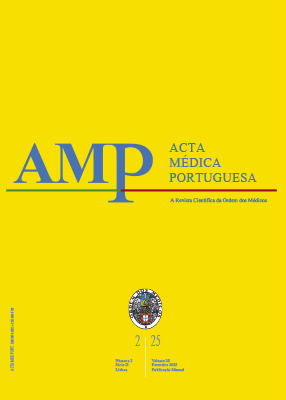Determinants of Adolescent Pregnancy in the Municipality of Malanje, Angola: A Case-Control Study
DOI:
https://doi.org/10.20344/amp.22407Keywords:
Angola, Pregnancy in Adolescence, Sexual Behavior, Sociodemographic FactorsAbstract
Introduction: Adolescent pregnancy is a global public health problem, with some of the highest rates observed in Sub-Saharan Africa. This phenomenon contributes to maternal and neonatal mortality and may result in diverse economic and psychological consequences. Knowledge of its determinants can help decision-makers to design local policies of sexual and reproductive health. Therefore, the aim of this study was to analyze the determinant factors of adolescent pregnancy in the municipality of Malanje, Angola.
Methods: A case-control study was conducted from August to October, 2022. A sample of 411 adolescent women (137 pregnant and 274 non-pregnant) was compared in terms of socio-demographic, behavioral, family, and extra-family factors. Descriptive statistics, binary univariate and multivariate logistic analysis were applied, with p-values ≤ 0.05 indicating statistical significance. Adjusted odds ratio (AOR) and the respective 95% confidence interval (95% CI) were obtained.
Results: The multivariable analysis showed that a higher risk of adolescent pregnancy was associated with living in a de facto union or being married (AOR = 10.37; 95% CI = 1.05 - 102.83), having 0 - 4 (AOR = 7.40; 95% CI = 1.25 - 43.77) or 5 - 8 years of schooling (AOR = 5.21; 95% CI = 1.25 - 21.77), and a lower risk was related with having a family history of adolescent pregnancy (AOR = 0.30; 95% CI = 0.11 - 0.80) for women aged 15 - 17. For those aged 18 - 19, a higher risk of pregnancy was associated with early sex initiation (AOR = 3.75; 95% CI = 1.05 - 13.43), having multiple sexual partners (AOR = 3.02; 95% CI = 1.23 - 7.44), while a lower risk was related with peer pressure (AOR = 0.35; 95% CI = 0.15 - 0.82). In both groups, the likelihood of pregnancy was significantly increased for irregular or non-use of contraceptive methods.
Conclusion: In Malanje, adolescent pregnancy is a multifactorial phenomenon, and preventive strategies must consider the adolescents’ age. Among adolescents aged 15 - 17, early marriages, should be reduced, through the promotion of education and the creation of specific laws. For older adolescents, preventive strategies should be focused on avoiding risky behaviors such as early initiation of sexual activity and multiple sexual partners. Comprehensive sexual education, including knowledge about contraceptive methods should be promoted.
Downloads
References
World Health Organization. Adolescent pregnancy. 2023. [cited 2023 Jun 12]. Available from: https://www.who.int/news-room/fact-sheets/ detail/adolescent-pregnancy.
World Health Organization. The global health observatory: adolescent birth rate (per 1000 women). 2024. [cited 2024 Sep 18]. Available from: https://www.who.int/data/gho/data/indicators/indicator-details/GHO/ adolescent-birth-rate-(per-1000-women-aged-15-19-years).
Eyeberu A, Getachew T, Sertsu A, Sisay M, Baye Y, Debella A, et al. Teenage pregnancy and its predictors in Africa: a systematic review and meta-analysis. Int J Health Sci. 2022;16:47-60.
United Nations Population Fund Angola. Annual report: summary of main activities and results. 2020. [cited 2023 May 08]. Available from: https://angola.unfpa.org/en/publications/unfpa-angola-2020-annualreport- activities-and-results.
Asmamaw DB, Tafere TZ, Negash WD. Prevalence of teenage pregnancy and its associated factors in high fertility sub-Saharan Africa countries: a multilevel analysis. BMC Womens Health. 2023;23:23.
Vogel JP, Fawole B, Adeniran AS, Adegbola O, Oladapo OT. Millennium development goal 5 and adolescents: looking back, moving forward. Arch Dis Child. 2015;100:S43-7.
World Health Organization. Health in 2015: from millenium development goals to sustainable development goals. 2015. [cited 2023 May 08]. Available from: https://www.who.int/publications/i/item/9789241565110.
Grønvik T, Fossgard Sandøy I. Complications associated with adolescent childbearing in Sub-Saharan Africa: a systematic literature review and meta-analysis. PLoS One. 2018;13:e0204327.
Indarti J, Al Fattah AN, Dewi Z, Hasani RD, Mahdi FA, Surya R. Teenage pregnancy: obstetric and perinatal outcome in a tertiary centre in Indonesia. Obstet Gynecol Int. 2020;2020:1-5.
Pietras J, Jarząbek-Bielecka G, Mizgier M, Markowska A. Adolescent pregnancy – medical, legal and social issues. J Matern Fetal Neonatal Med. 2024;37:1-5.
Ganchimeg T, Ota E, Morisaki N, Laopaiboon M, Lumbiganon P, Zhang J, et al. Pregnancy and childbirth outcomes among adolescent mothers: a World Health Organization multicountry study. BJOG: Int J Obstet Gynaecol. 2014:121;S40-8.
Wu H, Zhao M, Liang Y, Liu F, Xi B. Maternal age at birth and neonatal mortality: associations from 67 low-income and middle-income countries. Paediatr Perinat Epidemiol. 2021;35:318-27.
Ochieng Arunda M, Agardh A, Larsson M, Asamoah BO. Survival patterns of neonates born to adolescent mothers and the effect of pregnancy intentions and marital status on newborn survival in Kenya, Uganda, and Tanzania, 2014–2016. Glob Health Action. 2022;15:2101731.
Leftwich HK. Alves MV. Adolescent pregnancy. Pediatr Clin North Am. 2017;64:381-8.
Mutahi J, Larsen A, Cuijpers P, Peterson SS, Unutzer J, McKay M, et al. Mental health problems and service gaps experienced by pregnant adolescents and young women in Sub-Saharan Africa: a systematic review. EClinicalMedicine. 2022;44:101289.
Yakubu I, Salisu WJ. Determinants of adolescent pregnancy in sub- Saharan Africa: a systematic review. Reprod Health. 2018;15:15.
Mekonen EG. Pooled prevalence and associated factors of teenage pregnancy among women aged 15 to 19 years in sub-Saharan Africa: evidence from 2019 to 2022 demographic and health survey data. Contracept Reprod Med. 2024;9:26.
Kefale B, Yalew M, Damtie Y, Adane B. A multilevel analysis of factors associated with teenage pregnancy in Ethiopia. Int J Womens Health. 2020;12:785-93.
Ochen AM, Chi PC, Lawoko S. Predictors of teenage pregnancy among girls aged 13–19 years in Uganda: a community based case-control study. BMC Pregnancy Childbirth, 2019;19:211.
Moshi FV, Tilisho O. The magnitude of teenage pregnancy and its associated factors among teenagers in Dodoma Tanzania: a communitybased analytical cross-sectional study. Reprod Health. 2023;20:28.
Mbulu CO, Yang L, Wallen GR. Adolescent pregnancy persists in Nigeria: does household heads’ age matter? PLOS Glob Public Health. 2024;4:e0003212.
Ayele BG, Gebregzabher TG, Hailu TT, Assefa BA. Determinants of teenage pregnancy in Degua Tembien District, Tigray, Northern Ethiopia: a community-based case-control study. PLoS One. 2018;13:e0200898.
Chung HW, Kim EM, Lee JE. Comprehensive understanding of risk and protective factors related to adolescent pregnancy in low- and middleincome countries: a systematic review. J Adolesc. 2018;69:180-8.
Chitumba HO, Nungulo VN, Kahuli CN. Perfil das adolescentes grávidas atendidas no centro de saúde materno-infantil da mineira (Huambo, Angola). Rev Port Inv Comport Soc. 2022;8:1-15.
Gembi FT. Gravidez na adolescência em contexto angolano: estudo acerca dos fatores de risco e de proteção, em enfoque no funcionamento familiar. Coimbra: Universidade de Coimbra; 2012. [cited 2024 Sep 18]. Available from: https://estudogeral.uc.pt/handle/10316/26167?locale=pt.
Vundule C, Maforah F, Jewkes R, Jordaan E. Risk factors for teenage pregnancy among sexually active black adolescents in Cape Town. A case control study. S Afr Med J. 2001;91:73-80.
United Nations Children’s Fund. Report on the regional forum on adolescent pregnancy, child marriage and early union in south-east Asia and Mongolia. 2018. [cited 2022 Jan 10]. Available from: https://www. unicef.org/eap/media/3696/file/Adolescent%20pregnancy.pdf.
Bhona FM, Gebara CF, Noto AR, Vieira MD, Lourenço LM. Interrelações da violência no sistema familiar: estudo domiciliar em um bairro de baixa renda. Psicol Reflex Crit. 2014;27:591-8.
Downloads
Published
How to Cite
Issue
Section
License
Copyright (c) 2025 Acta Médica Portuguesa

This work is licensed under a Creative Commons Attribution-NonCommercial 4.0 International License.
All the articles published in the AMP are open access and comply with the requirements of funding agencies or academic institutions. The AMP is governed by the terms of the Creative Commons ‘Attribution – Non-Commercial Use - (CC-BY-NC)’ license, regarding the use by third parties.
It is the author’s responsibility to obtain approval for the reproduction of figures, tables, etc. from other publications.
Upon acceptance of an article for publication, the authors will be asked to complete the ICMJE “Copyright Liability and Copyright Sharing Statement “(http://www.actamedicaportuguesa.com/info/AMP-NormasPublicacao.pdf) and the “Declaration of Potential Conflicts of Interest” (http:// www.icmje.org/conflicts-of-interest). An e-mail will be sent to the corresponding author to acknowledge receipt of the manuscript.
After publication, the authors are authorised to make their articles available in repositories of their institutions of origin, as long as they always mention where they were published and according to the Creative Commons license.









